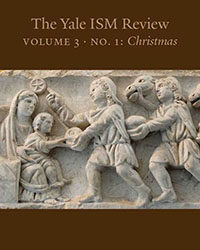R. Guy Erwin
It may come as a surprise to some that thoughts on Calvary would form the endnote to a collection of reflections on Jesus’s birth, but it shouldn’t. The two are inextricably linked. The story of God’s incarnation in human form in Jesus is at the very heart of Christian teaching, and Jesus’s birth and death are the two moments in which that Incarnation is most poignantly expressed.
Both in iconography and Christian folklore, it was in medieval Europe that the conventions of depiction and description of the nativity and crucifixion of Jesus became stylized and standardized. Medieval writers and artists illustrated both the birth and death of Christ with great vividness. Every detail that could be found in the gospels was teased out and harmonized into a single expanded script by devotional writers. Gaps and missing details in the story were filled by pious imagination, each writer adding his own gloss to the versions of earlier authors. By the time of Ludolph of Saxony (ca. 1295–1378), there was a treasury of lore and information about these events; his Vita Christi (1374) filled four volumes of text in its nineteenth-century printed form, much of it focused on Jesus’s passion and death.
The same phenomenon can be observed in the visual art of the period: Passion cycles were a tremendously popular and very important form of religious art from Giotto onward. Laid out like a storyboard, medieval altarpiece panels and devotional paintings telling the Passion story shaped forms of piety, such as the Stations of the Cross, that still have power and have influenced the devotion of centuries of Christians. Nativity pictures, too, especially pictures of the adoration of the Holy Child by the shepherds and Magi, helped cement in the Christian imagination a sense of Jesus as God in human form.
These immensely popular images proliferated—so much so that they are a commonplace in museums and libraries and churches today. Each of us can probably bring one or more of them easily to mind. Pictures of the Nativity enabled the artists to use their imaginations: the settings vary from simple stables to grottos to the ruins of ancient buildings. The number of people and animals varies too. But the constant is Mary, after the Christ child the most central figure: serene, contemplative, quietly joyful. Joseph is often on the sidelines.
In contrast to the expressive variety of the Nativity pictures, the conventional depiction of the Crucifixion is fairly simple: the cross squarely in the center, dividing the scene; Jesus’s arms stretched out, head tilted to his right, knees slightly bent, hair and loincloth either hanging limply or stirred by the breeze. Both in painting and in sculpture, John and Mary have first place at the foot of the cross. Here too, artists worked in smooth grooves of devotional and pious custom: the grief-stricken Mary’s red and blue dress is repeated in countless versions; John’s curly hair and mournful gaze have been depicted hundreds of times in hundreds of ways.
What brings these two images, Nativity and Crucifixion, together? The sense that to some degree they make the same point: God’s redemptive love shown in humility and self-giving. Ludolph of Saxony made this explicit by seeing in the Nativity the real starting point of the Passion story. This isn’t universal, to be sure; for most others, it was Jesus’s agony in the Garden of Gethsemane that starts the Passion story; for others, the judgment before Pilate. Some even go back as to include the Last Supper and Jesus’s long farewell speech. But Ludolph, and those influenced by him, take the longer view, and look all the way back to the beginning, and claim the Nativity itself as the start of the Passion story.
In a world such as ours, which separates so strongly and defensively the joy of living from the fear of dying, to claim that Jesus was one who—quintessentially—was born in order to die, can seem shocking and morbid to moderns. Surely no one could see in the infant in the manger a child-sacrifice as of old? Surely God had brought us out of that terrible mindset and into a new paradigm of life and death and life to come? But the child of Bethlehem, the center of the story and the picture, framed and encompassed by the wood of the manger, was from his birth the very Son whose life would both end and be fulfilled on a wooden cross on Calvary—from the grotto to the windswept hill in a single short lifetime.
And there it is. Mary, giving birth in pain, in the discomfort and uncertainly of a stable, far from home and her kinfolk, represents the unlikely fact that God’s work of salvation would be completed through humble people in humble places. The grieving Mary at the cross, about to lose her son, and still, by our standards, relatively young—most likely not past fifty—is every mother who outlives a child. Her grief on Calvary, like her joy at Bethlehem, is part of an ancient human story that touches every woman who bears or loses a child, indeed every parent.
Some medieval writers, including Ludolph, make it very explicit: the Passion of Christ begins with his human birth, in pain and blood; or in his circumcision in the flesh, where a drop of blood shed becomes a foreshadowing and the first of the wounds to come. We modern folk can take this into our own context and discover its parallels now—seeing in this story an unexpected, maybe even unwanted, birth in an inconvenient place; a flight as refugees from their homeland to an inhospitable neighboring country; and the challenges of being different in a traditional society. All of these disadvantaged the infant Jesus and his small family, just as millions suffer today.
Martin Luther, though not inclined to draw the line from the manger to the cross as directly as Ludolph, nonetheless used the Nativity story just over a century later to emphasize the completeness of Jesus’s coming in the flesh. No theologian but Luther has ever used in such a colorful way Jesus’s soiled diapers as a sign of God’s complete self-giving in the Incarnation—an earthy touch we can still appreciate. Luther drank deeply at the well of late-medieval Passion piety, and described both the Nativity and the Passion with vivid detail in his sermons for the seasons of Christmas and Lent in word pictures that still have the capacity to surprise and engage the reader’s emotions.
Can we still see Calvary from Bethlehem? Keeping the end of the story in mind can enrich our appreciation of the whole life of Jesus as a witness to divine solidarity with humankind in the Incarnation. Jesus’s humanity comes into especially high relief in these two life events in which he is not even a fully active participant: in entering life he is helpless; in leaving it he is often passive. Exegesis and homiletics have moved us away from the wonder of Jesus’s birth and death and more deeply into Jesus’s words and teachings, but there is something fundamental and elemental about an Incarnation that gathers the whole Jesus event—both birth and death—into one supreme expression of divine and human love.
To link these two stories together is also to lift up Mary’s role as witness and participant, and as a symbol of love and loss. It was not lost on the devotional tradition that Mary was, from the moment of the Annunciation, a powerful and essential part of Jesus’s story. When the Nativity and Crucifixion are lifted up as a pair, Mary’s role becomes even more important: she is the only person besides Jesus who was present at both. Her life thus frames her son’s, in joy and in grief. Mary is not only Jesus’s human parent, but also the first witness to God’s remarkable work in the world through his miraculous birth.
From the grotto to the hill, from the wood of the manger to the wood of the cross, from swaddling cloths to a seamless garment, from Bethlehem to Jerusalem: Jesus and Mary move through Jesus’s life with the inexorability and gravity of a liturgical procession. And we move with them, from Christmas to Easter, every year.
 R. Guy Erwin is Bishop of the Southwest California Synod of the Evangelical Lutheran Church in America. He oversees 120 congregations in five counties in the western half of Southern California, including the City of Los Angeles. For over twenty years before his election as bishop in 2013, he was a professor of church history and historical theology. Educated at Harvard College and the Yale Graduate School, he completed his PhD at Yale in 1999. By then he had taught several years in Yale College and the Yale Divinity School. His last academic appointment was as Belgum Professor of Lutheran Confessional Theology at California Lutheran University. He held that chair from 2000 to 2013. Erwin is a frequent speaker on topics related to Martin Luther, the Reformation, and Lutheran history generally.
R. Guy Erwin is Bishop of the Southwest California Synod of the Evangelical Lutheran Church in America. He oversees 120 congregations in five counties in the western half of Southern California, including the City of Los Angeles. For over twenty years before his election as bishop in 2013, he was a professor of church history and historical theology. Educated at Harvard College and the Yale Graduate School, he completed his PhD at Yale in 1999. By then he had taught several years in Yale College and the Yale Divinity School. His last academic appointment was as Belgum Professor of Lutheran Confessional Theology at California Lutheran University. He held that chair from 2000 to 2013. Erwin is a frequent speaker on topics related to Martin Luther, the Reformation, and Lutheran history generally.
____
This material is licensed under a Creative Commons Attribution 4.0 License.
Recommended Citation: Erwin, R. Guy. (2016) “Can We Still See Calvary From Bethlehem?” The Yale ISM Review: Vol. 3: No. 1, Article 8. Available at: https://ismreview.yale.edu
